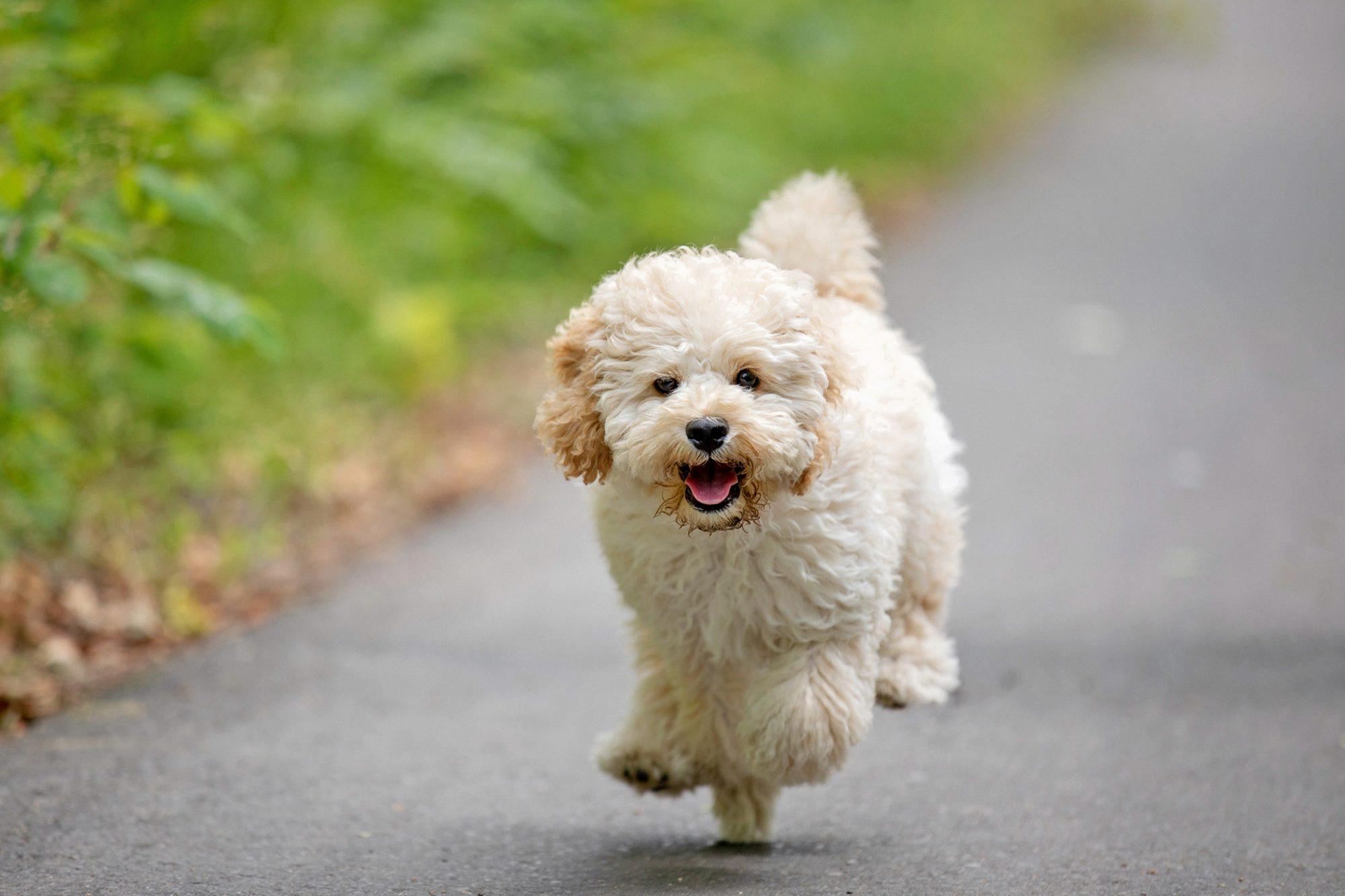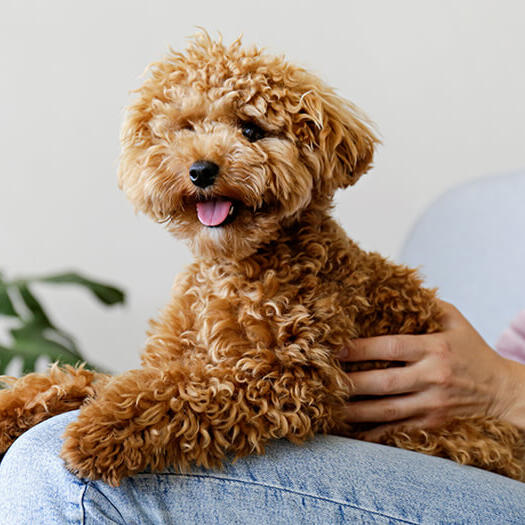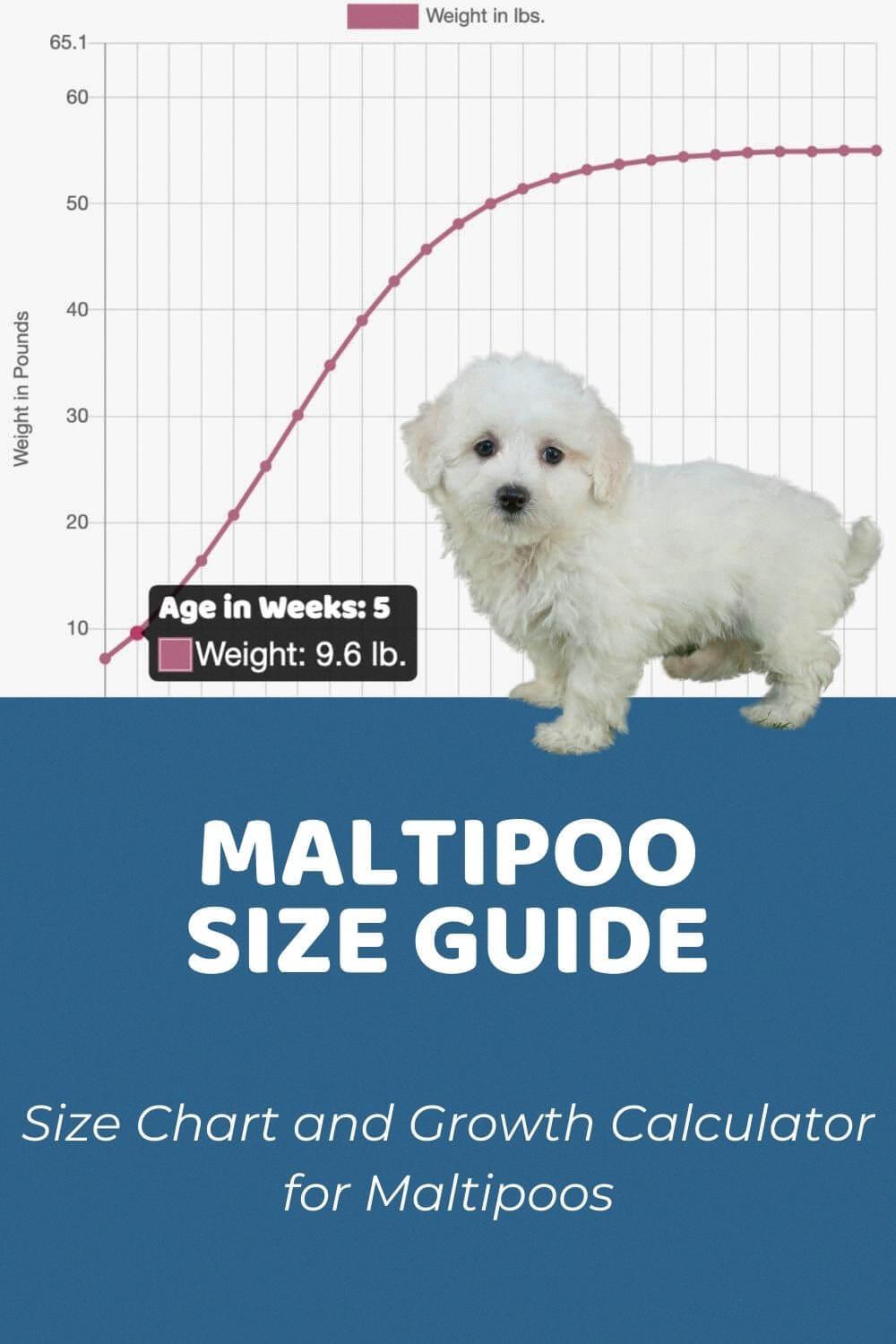Maltipoos are a popular designer breed that is a cross between a Maltese and a Poodle. These adorable little pups are known for their affectionate and loving personalities, as well as their fluffy, hypoallergenic coats. If you’re considering getting a Maltipoo, one of the most common questions you might have is how big they get.
Generally speaking, Maltipoos are considered small dogs. They typically won’t grow to be more than 14 inches tall, which puts them in the same category as other small breeds like Chihuahuas and Pomeranians. However, the exact size of your Maltipoo will depend on a few different factors, including their parents’ size and the specific type of Maltipoo you get.
There are a few different sizes of Maltipoos, including Toy, Tiny, Miniature, and Medium. Toy and Tiny Maltipoos are the smallest, and they typically reach their full adult size when they’re between 9 and 11 months old. This means that if you get a Toy or Tiny Maltipoo, you can expect them to be fully grown and at their adult weight by the time they’re just shy of a year old.
Miniature and Medium Maltipoos are a bit bigger, and they usually finish growing a bit later than Toy and Tiny Maltipoos. These pups typically reach their full adult size by the time they’re between 11 and 13 months old. Again, the exact size of your Maltipoo will depend on their parents’ size and the specific type of Maltipoo you get.
In terms of weight, Maltipoos can range anywhere from 5 to 20 pounds. This is a pretty wide range, so it’s important to consider the potential size of your Maltipoo when you’re deciding whether or not they’re the right breed for you. If you’re looking for a truly tiny dog that you can carry around in a purse, a Toy or Tiny Maltipoo might be the perfect fit. However, if you’re looking for a slightly bigger dog that still falls into the small breed category, a Miniature or Medium Maltipoo might be a better choice.
It’s worth noting that while Maltipoos are small dogs, they can still have big personalities. These pups are known for bing smart, playful, and affectionate. They can also be sensitive to changes in their environment or routine, so it’s important to provide them with a stable and consistent home. Maltipoos generally get along well with other dogs and pets, and they can be great companions for families with children who are old enough to handle a small dog.
Maltipoos are small dogs that typically won’t grow to be more than 14 inches tall. Their weight can range from 5 to 20 pounds, depending on their parents’ size and the specific type of Maltipoo you get. If you’re considering getting a Maltipoo, it’s important to consider their potential size and personality to make sure they’re the right fit for you and your family.
Reaching Full Growth: The Age of a Maltipoo
Maltipoos, a popular hybrid dog breed, are a cross between a Maltese and a Poodle. They are known for their energy, intelligence, and affectionate nature. If you’re consiering getting a Maltipoo, you might be wondering at what age they become fully grown.
Maltipoos come in different sizes, including Toy, Tiny, Miniature, and Medium. The size of a Maltipoo can affect how quickly they reach their adult weight and size.
In general, Toy or Tiny Maltipoos reach their adult weight and size when they’re 9-11 months old. At this age, they will have reached their maximum height and weight, and their bones and muscles will have fully developed.
Miniature and Medium Maltipoos, on the other hand, finish growing around 11-13 months of age. This means that they may take a little longer to reach their full adult size compared to Toy or Tiny Maltipoos.
It’s important to note that while Maltipoos may be fully grown by these ages, they will still require ongoing care and attention to maintain their health and wellbeing. Regular exercise, a nutritious diet, and regular vet check-ups are essential to keep your Maltipoo healthy and happy.
The age at which a Maltipoo becomes fully grown depends on their size. Toy or Tiny Maltipoos reach their adult weight and size at 9-11 months, while Miniature and Medium Maltipoos finish growing around 11-13 months of age.

Source: dailypaws.com
Size of a Maltipoo Dog
Maltipoos are widely considered to be small dogs. They are not classified as medium-sized dogs due to their petite stature. These dogs are typically no taller than 14 inches when fully grown, which places them squarely in the small dog category. In addition, Maltipoos have a weight range that falls between 5-20 pounds, which is consistent with most small dog breeds. Their soft coat is usually medium-to-long in length, and it tends to be wavy or curly in texture. Maltipoos are a small breed that is well-suited for apartment living and other settings where space may be limited.
The Disadvantages of Owning a Maltipoo
Maltipoos, like any other breed, have their downsides that potential owners should be aware of before making a decision. One of the main downsides of a Maltipoo is their sensitivity to changes in the environment and chaos in general.
These pups are known to have a more delicate temperament and can get easily overwhelmed in chaotic or noisy environments. This means that if you have a hectic home or move around a lot, a Maltipoo may not be the best choice of a furry friend.
Additionally, Maltipoos require a lot of attention and socialization to prevent separation anxiety and other behavioral issues. If you have a busy lifestyle that does not allow for frequent interaction or socialization with your pup, then a Maltipoo may not be the right fit for you.
Furthermore, Maltipoos are not hypoallergenic, and some people with allergies may still experience allergic reactions to their dander or saliva. It’s important to note that no dog breed is entirely hypoallergenic, but some may be more tolerable for people with allergies.
The downsides of a Maltipoo include their sensitivity to changes in the environment, their need for attention and socialization, and their potential to cause allergic reactions in some people. It’s essential to consider thee factors before bringing a Maltipoo into your home to ensure that you can provide them with the care they need to thrive.
The Benefits of Owning a Maltipoo Dog
Maltipoos can make excellent pets for the right family. With their adorable appearance and friendly personality, they are a popular choice for many people. However, before deciding to get a Maltipoo, it’s important to consider several factors.
Firstly, Maltipoos are small dogs, which makes them ideal for apartment living. They don’t require a lot of space to run around, which makes them suitable for people who live in smaller homes. Additionally, Maltipoos are known for being easy to train, which makes them a great choice for first-time dog owners.
Maltipoos are also known for being gentle and loving, which makes them great with kids. However, because they are small, they can easily be injured, so they are only recommended for families with children older than six who know how to handle dogs.
Moreover, Maltipoos generally get along well with other dogs and pets, making them a good choice for families with multiple pets. They are also low-shedding dogs, which makes them hypoallergenic, making them a great choice for people with allergies.
Maltipoos can be an excellent choice for families loking for a friendly, easy-to-train, and low-maintenance dog. However, it’s important to consider their size and fragility, especially around young children.
Frequency of Maltipoo Peeing and Pooping
Maltipoos, just like any other dog breed, need to pee and poop regularly to maintain their health and well-being. As a pet parent, it’s essential to understand your puppy’s bathroom routine and provide them with the necessary opportunities to relieve themselves.
On average, Maltipoos need to pee and poop 15-20 minutes after they eat. This is because food stimulates their digestive system, and they feel the urge to eliminate waste. However, keep in mind that every puppy is different, and some may need to go more frequently than others. It’s crucial to observe your Maltipoo’s behavior and schedule potty breaks accordingly.
For young Maltipoo puppies, the frequency of peeing and pooping is much higher than adult dogs. A general rule of thumb is to take your puppy out every 2 hours for a 2-month-old puppy, every 3 hours for a 3-month-old puppy, and so on. As your puppy grows and their bladder control improves, you can gradually increase the time between potty breaks.
It’s also important to pay attention to your Maltipoo’s body language and behavior. Some puppies may bark, whine, or scratch at the door to signal that they need to go outside. Others may circle around, sniff the ground, or act restless. It’s crucial to be aware of these cues and take your puppy out promptly to avoid accidents indoors.
Maltipoos need to pee and poop regularly to maintain their health and well-being. Pet parents should observe their puppy’s behavior and schedule potty breaks accordingly. For young puppies, it’s essential to take them out frequently, and as they grow, you can gradually increase the time between potty breaks. By being aware of your Maltipoo’s bathroom routine and behavior, you can keep them healthy, happy, and accident-free.

Do Maltipoos Have a Tendency to Bark?
Maltipoos are a popular breed that is a mix of Maltese and Toy Poodle. One common question that many people have when considering this breed is whether or not Maltipoos bark a lot.
The answer to this question is that Maltipoos do bark, but not excessively or aggressively. Both Maltese and Toy Poodles are known for being relatively quiet breeds, and this trait is generally passed down to their Maltipoo offspring. However, it’s important to remember that all dogs are individuals and may have their own unique personalities and tendencies, so some Maltipoos may bark more than others.
It’s also worth noting that barking is a natural behavior for dogs, and it’s how they communicate with their owners and other dogs. However, excessive barking can be a nuisance for both the dog and their owners, so it’s important to train your Maltipoo to bark appropriately and not excessively.
There are several things you can do to help prevent excessive barking in your Maltipoo. First, make sure they are getting enough exercise and mental stimulation to help prevent boredom, which can lead to excessive barking. You can also train your Maltipoo to bark on command and then be quiet on command, which can help them learn appropriae barking behavior.
While Maltipoos do bark, it’s not typically a major issue with this breed. With proper training and attention to their needs, you can help ensure that your Maltipoo is a well-behaved and happy member of your family.
Comparing Maltese and Maltipoo Dogs
When it comes to deciding between a Maltese or a Maltipoo, there are severl factors to consider. Both breeds have their own unique characteristics and traits, and what may be the better option for one person may not be the best fit for another.
One of the main differences between Maltese dogs and Maltipoos is their size. Maltese dogs are typically smaller, weighing in at around 4-7 pounds, while Maltipoos can range from 5-20 pounds. This may be a deciding factor for some individuals, as they may prefer a smaller or larger dog.
Another factor to consider is their temperament. Maltese dogs are generally more independent than Maltipoos, and are less prone to separation anxiety. This means that they may be more suitable for individuals who work long hours or are away from home often. On the other hand, Maltipoos are known to be more affectionate and sociable, and may be a better fit for those who are looking for a companion dog.
When it comes to grooming and maintenance, both breeds require regular grooming to maintain their coat and prevent matting. However, Maltese dogs have a longer, silkier coat that requires more frequent brushing and grooming than Maltipoos, which have a wavy or curly coat that may be easier to maintain.
Lifespan is another factor to consider. Maltese dogs typically live longer than Maltipoos on average, and they are a more ancient breed compared to the newcomer Maltipoo dog hybrid.
Ultimately, the decision between a Maltese or a Maltipoo comes down to personal preference and lifestyle. It is important to research both breeds thoroughly and consider factors such as size, temperament, grooming, and lifespan before making a decision.
Frequency of Bathing a Maltipoo
Maltipoos are adorable and cuddly dogs that require regular grooming to keep their coat in good condition. One of the most important aspects of grooming your Maltipoo is bathing. However, it is essential to know how ofen to bathe your Maltipoo to prevent any skin irritation or damage to their coat.
Bathing your Maltipoo too often can strip away essential body oils that keep their coat shiny and healthy. On the other hand, not bathing them enough can lead to a buildup of dirt, grime, and bacteria, which can cause itching, odor, and infections. So, what is the ideal frequency for bathing your Maltipoo?
Experts recommend giving your Maltipoo a bath once every 3 weeks. This frequency strikes a balance between keeping your dog clean and healthy without causing any harm to their coat or skin. Bathing them more than this frequency can cause their skin to dry out, leading to flakiness, itching, and other skin conditions.
However, there are situations when you may need to bathe your Maltipoo more frequently. For example, if your dog loves to roll in the mud, or if they get into something smelly, a bath may be necessary. In such cases, use a mild dog shampoo, and make sure to rinse thoroughly to remove all soap residue.
Maltipoos should be bathed once every 3 weeks, unless there are exceptional circumstances where a bath is necessary. Regular grooming, including brushing and trimming, can help keep your Maltipoo’s coat healthy, shiny, and smelling fresh.
Are Maltipoos Calm Dogs?
Maltipoos are a crossbreed between a Maltese and a Poodle, known for their friendly nature and affectionate personality. When it cmes to their temperament, Maltipoos are generally calm dogs. They are not excessively energetic or hyperactive, which makes them great companions for families, seniors, and people with a more sedentary lifestyle.
However, like most dogs, Maltipoos can have their moments of excitement and playfulness. This is especially true when they are young and still in their puppy phase. As they grow older, they tend to become more relaxed and mellow.
The calm demeanor of Maltipoos can be attributed to their parent breeds. Maltese dogs are known for their gentle nature and Poodles are renowned for their intelligence and loyalty. These traits combine to create a well-balanced and friendly dog that is easy to train and gets along well with children and other pets.
It’s important to note that while Maltipoos are generally calm dogs, individual personalities can vary. Some Maltipoos may be more energetic and require more exercise and stimulation, while others may be more laid back and prefer to lounge around the house. It’s important to assess each dog’s individual needs and personality to ensure they receive the appropriate care and attention.
Maltipoos are calm dogs that make great companions for families and individuals seeking a friendly and affectionate pet. While they may have their moments of excitement and playfulness, they are generally well-balanced and easy-going dogs.

Source: populardoodle.com
Can Maltipoos Be Left Home Alone?
If you are considering getting a Maltipoo, one of the most important questions you might have is whether they can be left alone at home. The answer is yes, but with some important considerations.
The Maltipoo is a small dog that can adapt well to different living situations, including being left alone at home for a few hours. However, they shouldn’t be left alone for longer than four hours at a time. This is because they will still need to use the bathroom and are prone to social anxiety.
When left alone for extended periods, Maltipoos may become anxious and destructive. They may bark excessively or chew on furniture and other items. To prevent this, it’s important to provide them with plenty of exercise and mental stimulation before leaving them alone. This can include going for a walk, playing fetch, or proviing puzzle toys.
It’s also important to create a safe and comfortable environment for your Maltipoo when you are not home. This can include setting up a comfortable bed, providing access to water, and securing any hazardous items or areas. You may also consider leaving a radio or TV on to provide some background noise and make them feel less alone.
Maltipoos can be left alone at home, but only for short periods of time. It’s important to provide them with exercise and mental stimulation before leaving, and to create a safe and comfortable environment for them while you are away. By following these guidelines, you can ensure that your Maltipoo stays happy and healthy even when you’re not there.
Do Maltipoos Require a Lot of Sleep?
Maltipoos, a crossbreed between a Maltese and a Poodle, are known to be energetic and playful dogs. However, just like any other dog, Maltipoos require a significant amount of sleep to maintain their physical and mental health.
On average, Maltipoos sleep between 12 to 14 hours a day. This includes both nighttime sleep and daytime naps. Puppies and senior Maltipoos may require more sleep, while adult Maltipoos may sleep less but stil need a minimum of 10 hours of sleep a day.
Maltipoos are also known to be light sleepers and can be easily disturbed by noises or movements. Therefore, it’s important to ensure that they have a comfortable and quiet sleeping environment. Providing a cozy bed and avoiding loud noises or bright lights during their sleep time can help them get the rest they need.
In addition, Maltipoos, like most dogs, thrive on routine. Establishing a consistent sleep schedule and sticking to it can help them adjust to their sleeping patterns and ensure that they get the necessary amount of rest.
Maltipoos do sleep a lot, and it’s crucial to provide them with a comfortable and quiet sleeping environment, establish a consistent sleep schedule, and understand that they may require more sleep during certain stages of their life.
The Intelligence of Maltipoos
Maltipoos are intelligent dogs that possess a high level of intuition and energy. These dogs are a crossbreed between a Maltese and a Poodle, both of wich are known for their intelligence. Due to this background, Maltipoos are considered to be smart dogs.
Their intelligence makes them relatively easy to train, as they are quick learners and generally obedient. They can learn a variety of commands and tricks relatively quickly, making them an excellent choice for owners who want a dog that is easy to train.
Maltipoos have a happy and energetic nature, which makes them an excellent choice for families with children. They can provide endless hours of entertainment and companionship while also being a loyal and loving pet.
While Maltipoos can be stubborn at times, they are ultimately eager to please their owners. They are known for their loyalty and affectionate nature, making them an excellent companion for both singles and families.
Maltipoos are smart dogs that are known for their intelligence, intuition, energy, and happy nature. They are quick learners and can be easily trained, making them an excellent choice for owners who want a smart and obedient pet.
Average Cost of a Maltipoo
Maltipoos are a popular hybrid breed that combines the Poodle and Maltese breeds. If you’re considering adding a Maltipoo to your family, one of the first things you may be wondering is how much they cost.
The cost of a Maltipoo can vary widely depending on where you get your dog. Adopting from a shelter or rescue organization can cost anywhere from $100-$500, while purchasing from a reputable breeder can cost anywhere from $1,000-$4,000 or more.
Factors that can impact the cost of a Maltipoo from a breeder include the quality of the breeding stock, the reputation of the breeder, and any additional services or guarantees that come with the purchase. For example, some breeders may offer a health guarantee or include microchipping in the price.
It’s important to note that while adopting from a shelter may be less expensive upfront, you may incur additional costs for things like vaccinations, spaying or neutering, and othr medical expenses.
The cost of a Maltipoo can range from $100-$4,000 depending on where you get your dog and what services are included. It’s important to do your research and choose a reputable source to ensure you’re getting a healthy and well-bred dog.

Source: doodledoods.com
Conclusion
Maltipoos are a popular hybrid breed that make for great companions. They are small in size, with a soft, wavy or curly coat that is low-shedding and hypoallergenic. Maltipoos are generally easy to train and get aong well with children and other pets. However, their sensitive nature means they may not be the best fit for households with a lot of chaos or frequent moves. It’s important to note that Maltipoos require regular grooming and exercise to keep them healthy and happy. if you’re looking for a loyal, affectionate, and adorable companion, a Maltipoo could be the perfect addition to your family.
